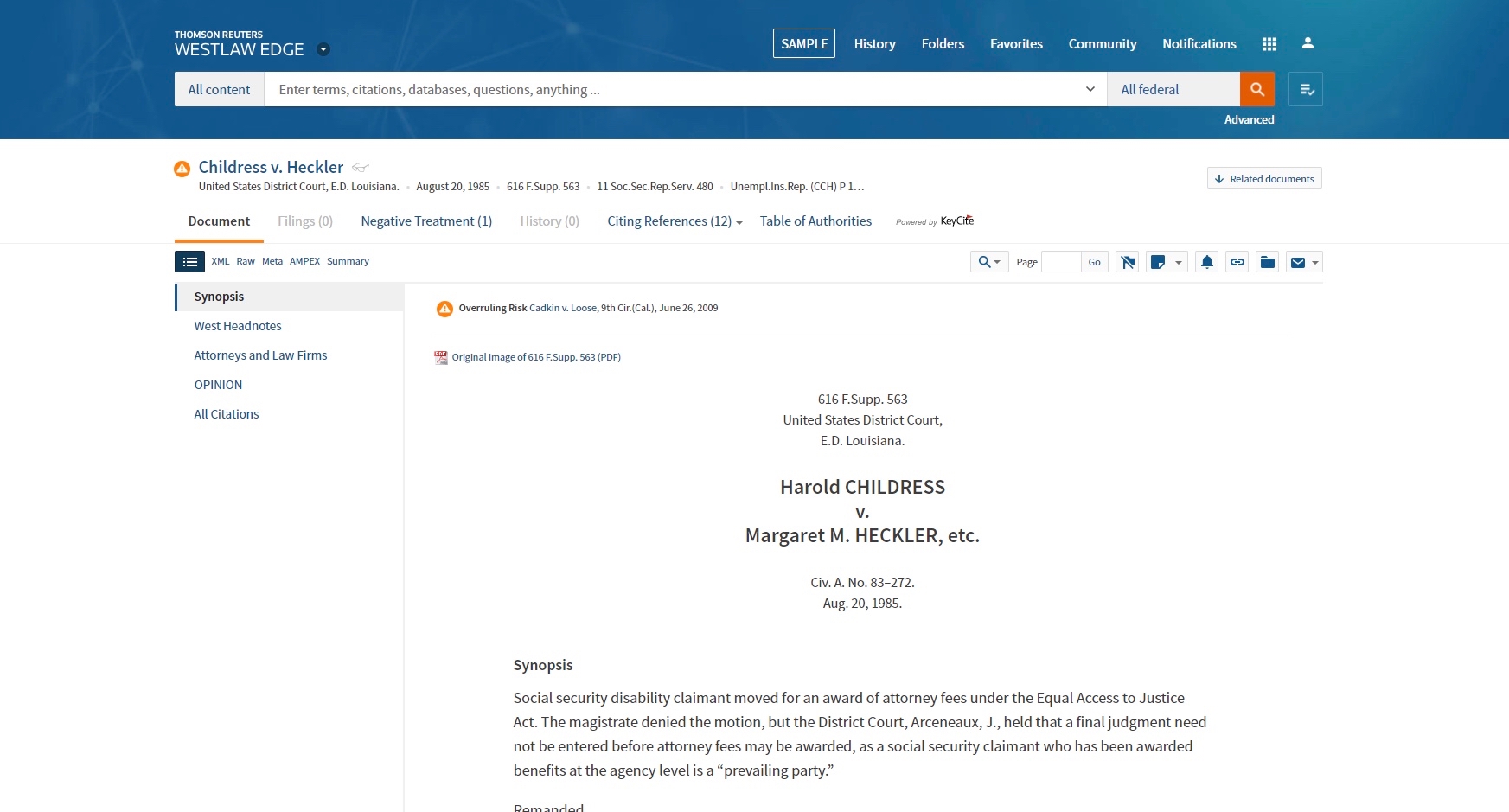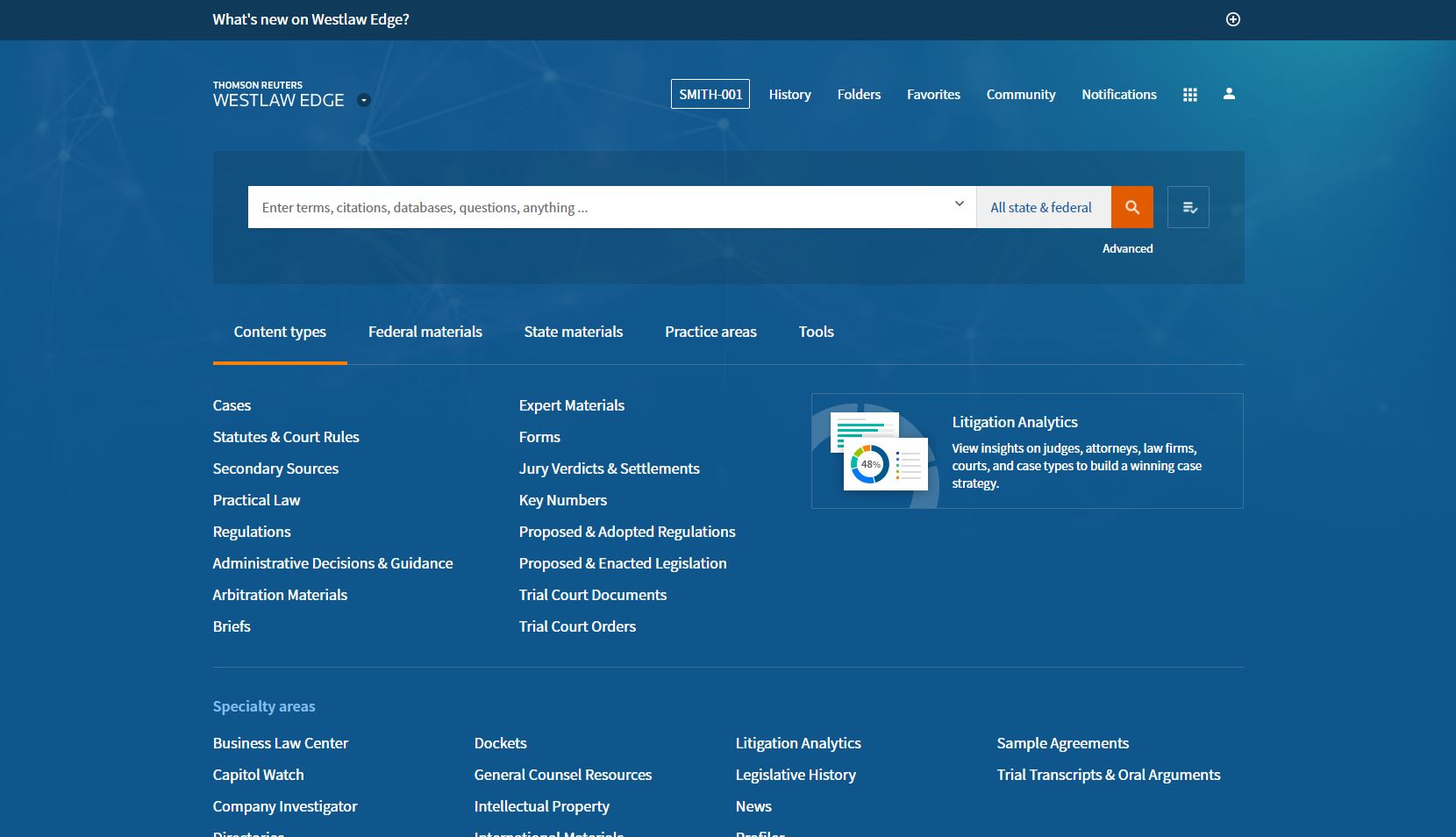It was eight years ago that Thomson Reuters unveiled WestlawNext to great fanfare, eventually phasing out classic Westlaw entirely. A lot has changed in those eight years, both in the legal market and in legal technology.
Today, Thomson Reuters is officially announcing its next-generation legal research platform, Westlaw Edge, which uses advanced artificial intelligence and analytics with the goal of helping legal professionals find answers and perform research more efficiently and with better results.
The most-striking features of Westlaw Edge are:
- An enhanced, AI-powered version of the KeyCite citator that provides warnings that cases may no longer be good law in circumstances that traditional citators could not identify.
- WestSearch Plus, an AI-driven legal research tool that guides lawyers quickly to answers to specific legal questions.
- Integrated litigation analytics, providing detailed docket analytics covering judges, courts, attorneys and law firms, for both federal and state courts.
- Statutes Compare, a tool that allows researchers to compare changes to statutes.
Westlaw Edge also includes a variety of user-experience improvements throughout the platform.
Westlaw Edge will be offered as a subscription upgrade to Westlaw subscribers. Thomson Reuters will continue to operate Westlaw in its current form until 2024, but it will focus most major development going forward on the new Westlaw Edge platform.
Bloggers and journalists attended a briefing yesterday at Thomson Reuters headquarters in New York where company executives presented an overview of Westlaw Edge. I’ve been given a password to test it, and I will write more when I get a chance to try it hands-on.
Here are key points from yesterday’s briefing.
Enhanced Citator
Westlaw Edge’s enhanced citator overcomes a shortcoming inherent in most citators, according to Mike Dahn, senior vice president, Product Management. In order to identify when a case overrules or invalidates a prior case, there needs to be a direct citation relationship between the cases. As a result, cases may no longer be good law, but may not be flagged by citators.

This enhanced citator uses machine learning and natural language processing to train the system to identify cases that may no longer be good law, even when there is no direct citation relationship. For those cases, it now identifies them with a new orange KeyCite warning. The warning does not necessarily mean the case has been overturned, but it tell the research to check into that.
WestSearch Plus
Currently on Westlaw, as well as on other legal research services, when you enter a search, what you get back are documents. You then work your way through those documents in pursuit of the subject of your research.
But sometimes what you want is simply to enter a question and get an answer as quickly as possible. That is what WestSearch Plus strives to provide. Ask a question and it will take you not only to relevant documents, but also to answers to thousands of questions lawyers are likely to ask. Westlaw Edge uses AI tools such as machine learning and natural-language processing, as well as Westlaw’s own headnotes and Key Number System, to suggest questions as you type a query and provide answers to those questions.
“I do want to be clear: We have not built a robot lawyer,” Dahn said. This will not answer every question a lawyer will have. But what it will do, he said, is help them get to the answer much faster.
This feature will also be available in a new Westlaw Edge iPhone app the company is releasing.
Litigation Analytics
Litigation analytics have become increasingly popular in recent years, with a number of products on the market – most notably Lex Machina, which was acquired by LexisNexis and is now becoming a core part of its research platform.

With Westlaw Edge, Thomson Reuters appears to have come out of the gate running in the litigation analytics competition. It appears to be a powerful set of analytics and to include more data and practice areas from both federal and state courts than any other product on the market.

It covers dockets for every federal case types except bankruptcy and includes some 8 million federal cases. It includes analytics for 13 types of federal motions – plus filters for subsets of those motions types – and for expert challenges.

Analytics are incorporated into research results. Previously in Westlaw, when you clicked on on the name of the judge in an opinion, you would see biographical information. With Westlaw Edge, you still get that, but in addition you get analytics showing a wealth of information about how the judge handles different types of cases and motions, how the judge’s opinions stand up on appeal, how long the judge takes to handle matters, and more.
You can drill down through the visualizations to get to the underlying documents. You can apply searches and filters to see how a judges handles a certain type of motion in a certain type of case, and then see the actual ruling. In addition, related litigation documents are also available, such as the parties’ briefs and motions.
Among the ways these analytics can be used, according to Dahn:
- Better understand a judge.
- Better understand opposing counsel.
- Venue evaluation for plaintiffs.
- Better understand case and motion timelines.
- Locate and evaluate local counsel.
- Prepare client pitches, showing the strengths of your firm or the weaknesses of others.
- Faster legal research.
State court analytics are not as robust as the federal analytics, in that they generally lack motion-level outcomes. (Although some state jurisdictions do have motion-level outcomes, including New York and Cook County in Illinois.)
Statutes Compare
Statutes Compare is a tool for analyzing changes to statutes. The tool compares two versions of a statute, using red-lining to show changes. By default, the tool compares the current version of a statute to the prior version, but the user can select any two historical versions for comparison.

The tool can be used with all federal and state statutes. However, there are a small number of states for which older historical versions are not available, only the most-recent changes.
User Experience Improvements
Westlaw Edge introduces a variety of small improvements to the user experience. One, for example, allows you to restore filters used in a previous search to apply them again in a new search. Another lets you expand or contract the synopsis at the top of a case with one click. Still another lets you see notes you’ve added to documents without leaving the document.
Dahn said that a lot of work was put into refining how documents are displayed, including refinements to fonts, line spacing and the like. A new document-level table of contents on the left of the screen shows you where you are in a document as you move through it. If you are in the dissent of an appellate opinion, for example, the table of contents will show that.
As noted above, Thomson Reuters will offer Westlaw Edge as an upgrade to Westlaw and will continue to operate both platforms. The company declined to specify pricing, but said it would be “extremely reasonable.” It will be rolled out to law professors later this summer and to law students next spring.
Better AI?
A key point that was repeatedly emphasized during yesterday’s briefing is that AI isn’t easy — at least AI done well. It’s not clear whether this was meant as a jab at other products on the market, but Thomson Reuters says its AI is distinguished in three significant ways:
- Editorial quality matters for AI performance, and TR has the largest team of attorney editors in the industry who concisely describe the essence of cases and add important terms for better recall and understanding.
- The quality of the data also matters, and TR has data enhanced by the Key Number system and sophisticated citation mapping.
- The team matters, and TR has a team of leading research scientists at its Center for AI and Cognitive Computing who developed the AI that powers Westlaw Edge.
Bottom Line
I’ll be testing out the new Westlaw Edge and will write more about my impressions and specific features. If the actual product lives up to the presentation I saw yesterday, then it is a major step forward, not only for Thomson Reuters, but for the industry.
At a time when any number of companies are offering legal research and intelligence tools using AI and analytics, Westlaw Edge appears to have the edge, offering features such as quick answers to legal questions, sophisticated analytics across all federal and state courts, better warnings about potentially bad case law, and more.
 Robert Ambrogi Blog
Robert Ambrogi Blog
